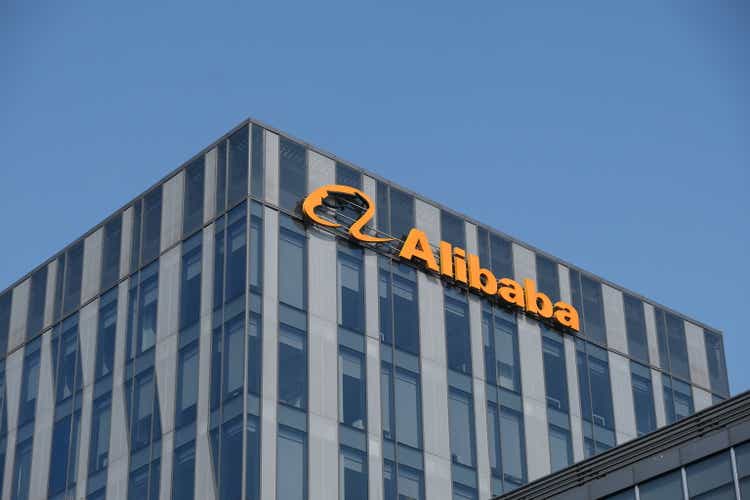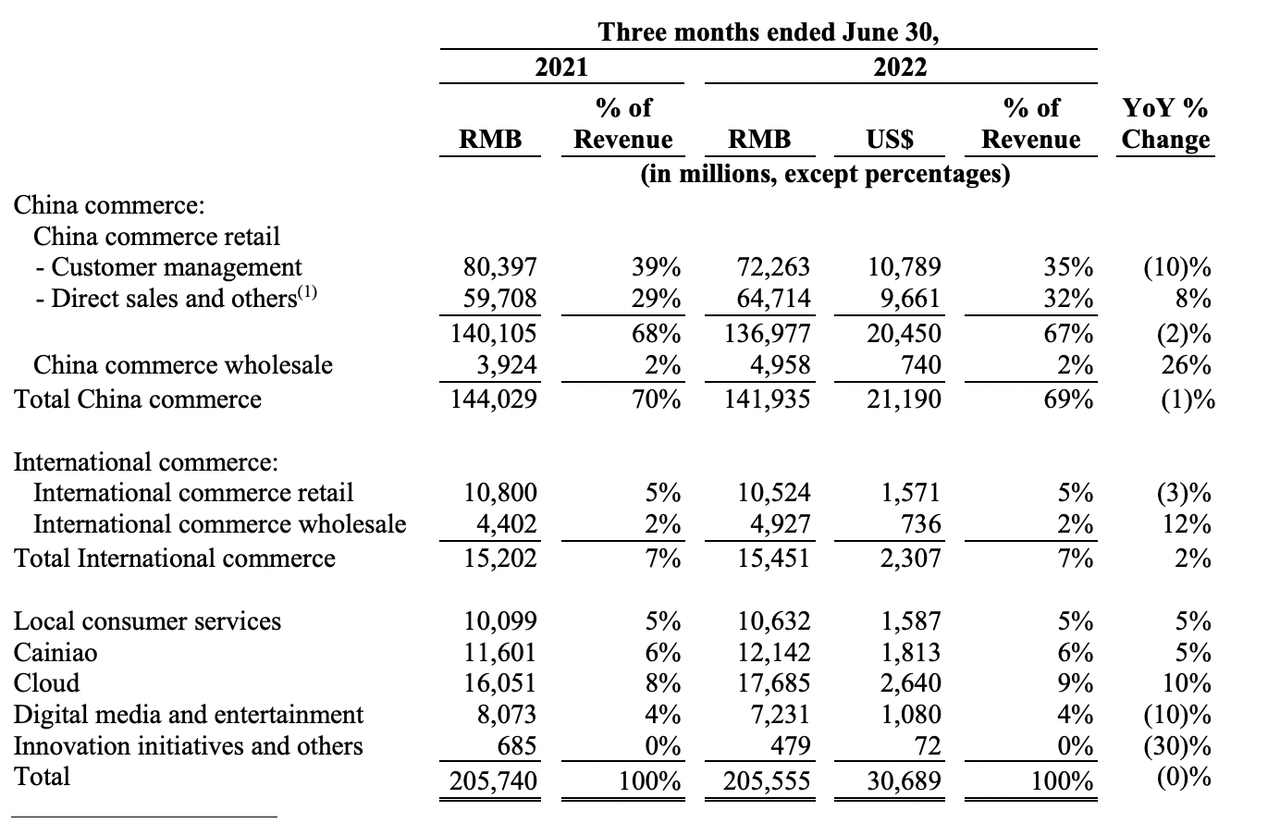
Robert Way
Alibaba Group Holding (NYSE:BABA) stock hasn’t been moving much lately. After bottoming at $72 back in March, it quickly regained much of its lost ground, eventually hitting a high of $120. Later, though, it got hit with a series of negative news stories and fell back to $90. The most damaging report was news that SoftBank (OTCPK:SFTBY) would sell part of its BABA stake, a large position (around 9% of the float) that hadn’t moved in decades. Alibaba’s most recent quarterly earnings beat estimates by 13%, but the subsequent rally (about 2%) was pretty mild. That may have been due to the SoftBank sale occurring around the same time.
One problem with Alibaba is that there haven’t been many positive catalysts for the stock. The last truly big story was the fiscal Q1 earnings release, which beat expectations, but not enough to get the stock moving. Apart from that, we just haven’t heard a whole lot. China recently cut lending rates, which moved the Hang Seng Index (including BABA) on Thursday, but there hasn’t been much heard about Alibaba individually. One catalyst, however, might be coming soon:
Alibaba gaining dual listing status on the Hong Kong Stock Exchange.
This month, BABA received approval for dual primary listing. It’s already dual-listed, but the primary listing in Hong Kong will enable its shares to trade on Stock Connect, a service that lets mainland Chinese people invest in Hong Kong. Currently, if you check the ticker lookup tool on Stock Connect, you’ll see that Alibaba isn’t among the shares eligible for the program. If it gains access to Stock Connect, then Alibaba will be easily available for Chinese investors to buy.
Why is that a catalyst?
Because the majority of Alibaba’s customers are in mainland China. Alibaba has 1.3 billion customers, including a billion in China and 300 million elsewhere. Today, it’s not easy for those billion customers to invest in BABA stock. With Stock Connect inclusion, that could change, serving as a major catalyst that triggers buying, taking BABA to new heights.
What is Stock Connect?

Map of Stock Connect (Goldman Sachs)
Stock Connect is a program that links the mainland Chinese and Hong Kong Stock markets.
According to Goldman Sachs (GS), these markets were historically separate. China officially maintains a “one country, two systems” policy toward Hong Kong. The city is legally part of China, but operates according to different institutions. In recent years, China’s control over Hong Kong has been increasing, but the city state is still different from mainland China in many ways. For example, Hong Kong is considered to be capitalist, unlike the mainland, which is “market socialist.”
One major difference between Hong Kong and the mainland is the two regions’ stock markets. Hong Kong has a stock exchange that largely trades tech stocks, including Alibaba. The mainland Chinese stock exchanges (Shanghai and Shenzhen) include more state-owned enterprises. Since 2014, mainland Chinese people have been able to buy Hong Kong shares via Stock Connect. However, not all Hong Kong shares are part of the program. According to the South China Morning Post, BABA currently isn’t eligible. That means that Mainland Chinese (i.e. the overwhelming majority of Alibaba’s customers) can’t invest. After dual primary listing is achieved, they will be able to invest.
This addition of new investors has the potential to add a lot of buying power. According to the WSJ, Chinese families put 15% of their savings in stocks. That’s a distant third after cash and real estate, but it’s not nothing. According to the government of China, the country is home to 494 million families. If each of them has $10,000 in savings, and 15% of it goes into stocks, then we’re seeing $741 billion worth of buying power going into the markets. Alibaba is a well-known brand in China, so it stands to reason that a nice chunk of that Chinese money will go into BABA. Therefore, it could easily offset the effect of SoftBank’s share sale and take the stock higher.
Alibaba Valuation
As we’ve seen, Alibaba has a major catalyst on the horizon that could take its stock price higher.
Note the key term here, though: could. The addition of potential buyers doesn’t guarantee that a stock will rise. For that to happen sustainably over the long term, the company needs an attractive valuation, or growth, or some combination of the above.
Where does Alibaba sit in this regard?
Pretty well. At today’s prices, BABA trades at:
-
12.6 times adjusted earnings.
-
1.95 times sales.
-
1.5 times book value.
-
11.48 times operating cash flow.
These are all very low multiples. Collectively, they suggest that the stock might be undervalued. Now, Alibaba’s growth has taken a hit in recent years, thanks to a regulatory crackdown in 2021 and a major COVID lockdown in 2022. So it’s not growing rapidly right now. However, China just recently announced a new round of stimulus, which lifted stocks on Thursday. If that plan stimulates not only stocks but also consumer spending, then Alibaba may be able to resume its previous high growth in the future.
If you want an “objective” assessment on what Alibaba stock is worth, you can do a discounted cash flow analysis. In a recent article, I assumed 0% free cash flow growth and a 2.8% discount rate, and got a $191 fair value estimate. I think that’s a reasonably safe price target, although the free cash flow I used that time didn’t include the just-reported quarter, which took the 12-month free cash flow a bit lower. If you update my model for the last quarter’s result, you get a $160 fair value estimate, which is down from my previous one, though still suggesting considerable upside. I also ran my model with higher discount rates; it continues having upside to today’s price at discount rates as high as 4.3%, at which level it’s worth $101. It’s worth noting that the Chinese 10-year bond yields 2.6% and the U.S. 10 year yields 3%. So, BABA beats the risk-free alternative (the opportunity cost of investing) in the world’s two largest countries.
Business Outlook
As I showed above, Alibaba stock has upside even if you assume 0% growth. This is confirmed by the stock’s recent price moves: BABA rallied 2% after an earnings release that showed 0% top-line growth. Certainly there’s a pure multiple expansion play here. But ideally, we’d want to see BABA start growing again.
Will it?
I think that, when China’s economy sorts out its current kinks, it will.
First off, the factors holding back retail spending in China last quarter were temporary. Chinese people were kept inside by lockdown orders that ravaged spending. Nike (NKE), Apple (AAPL) and other retailers all saw their China sales decline. It stands to reason, then, that if China backs off on Zero COVID, spending will resume.
We’re already seeing evidence of that happening. Recently, China dropped requirements for travellers to report COVID information when they arrive in China. The country’s most drastic easing of COVID restrictions yet, it could signal a Beijing that’s growing weary of COVID’s effect on its economy.
Second, Alibaba has business segments that grew even in the previous quarter, which had 0% growth overall. For example, the cloud. In fiscal Q1, it grew 10%, offsetting the decline in retail. Many investors have bemoaned the relatively slow growth in Alibaba’s cloud business compared to its U.S. peers, but the point still stands that it contributed to the company’s overall growth last quarter. If it continues to do so, it could be BABA’s ace in the hole.

Alibaba segment earnings (Alibaba)
Risks and Challenges
Given its cheap valuation and future potential, Alibaba stock looks like a compelling buy at today’s prices. You don’t need to make any aggressive assumptions about future growth to arrive at a fair value of $160, which is significant upside to today’s price. Basically, if Alibaba doesn’t shrink, its stock should reward shareholders in the future. Nevertheless, there are some risks and challenges to watch out for, including:
-
Geopolitical tensions. There have been some tensions between China and the U.S. lately. China has been conducting military exercises near Taiwan, which it considers part of its territory. The U.S., for its part, has been sending politicians to meet with Taiwanese officials, contrary to China’s wishes. Relations between these two countries are pretty icy. If a worst case scenario occurs, we could see a Russia-style package of sanctions that includes trading restrictions on Chinese stocks. That would definitely give Alibaba some short-to-medium term downside.
-
Competition. In its first quarter earnings release, Alibaba cited “fierce competition” as a reason for slower growth. Basically, China’s 2021 tech crackdown forced Alibaba to open up to competitors, by accepting Tencent’s (OTCPK:TCEHY) WePay app, and eliminating the “choose one of two” policy. Today, Alibaba is more vulnerable to competition than it was in 2020. So, watch out for big moves by JD (JD), Pinduoduo (PDD) and others. The government has given them some wiggle room to move in on Alibaba’s territory.
-
Delisting. Alibaba was recently added to the list of companies under scrutiny as part of the Holding Foreign Companies Accountable Act (“HFCAA”). If it can’t or won’t comply with the U.S.’s audit requirements, then it will be delisted from the NYSE in three years. That could cause some U.S. investors to lose interest, reducing the demand for Alibaba shares. Yes, there’s always Hong Kong, but that’s a less liquid market that some U.S. investors may not want to participate in.
The risks above are worth keeping in mind. So far, the geopolitical and delisting risks are “hypotheticals,” as they haven’t really damaged Alibaba’s core business yet. The competition risk is material; it did reduce growth in the first quarter, according to the company’s own management. Nevertheless, Alibaba stock is quite cheap, and we don’t even need growth for it to theoretically be worth $160. On the whole, it looks like a good value.


Be the first to comment